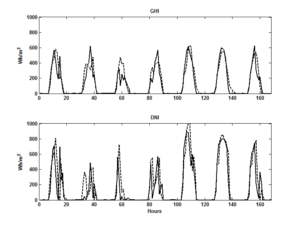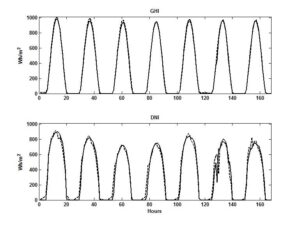I am pleased to devote a few words to the new working paper that we (Alberto Martín, Nikos Kourentzes and myself) have elaborated with the collaboration of the ISFOC that kindly provided the research data.
The paper reports the Dynamic Harmonic Regression applied to forecast the solar irradiance at short-term, but, why is this important? Generally speaking, solar power generation is a crucial research area for countries that suffers from high dependency on external energy sources and is gaining prominence with the current shift to renewable sources of energy (This is particularly true for Spain) . In order to integrate this generated energy into the grid, solar irradiation must be forecasted, where deviations of the forecasted value involve significant costs. It should be noted that the need for these forecasts are also required for other renewable resources as the wind.
Ejemplo de predicción con el método DHR (línea discontinua) frente a los datos reales de irradiación solar directa o DNI (línea continua)
In this working-paper we propose a univarivate Dynamic Harmonic Regression model set up in a State Space framework for short-term (1 to 24 hours) solar irradiation forecasting (take a look at the other blog post that we use the same technique to forecast electricity load and prices). Time series hourly aggregated as the Global Horizontal Irradiation and the Direct Normal Irradiation will be used to illustrate the proposed approach.
This method provides a fast automatic identification and estimation procedure based on the frequency domain. The recursive algorithms applied offer adaptive predictions and, since the method is based on unobserved components models, explicit information about trend, seasonal and irregular behaviour of the series can be extracted. The good forecasting performance and the rapid adaptability of the model to fast transient conditions of solar radiation are illustrated with minutely solar irradiance measurements collected from ground-based weather stations located in Spain.
Ejemplo de predicción con el método DHR (línea discontinua) frente a los datos reales de irradiación solar global o GHI (línea continua)
If you are interested in this work, please click here to download it. (it is freely available in researchgate)
For further information please contact me by e-mail.


